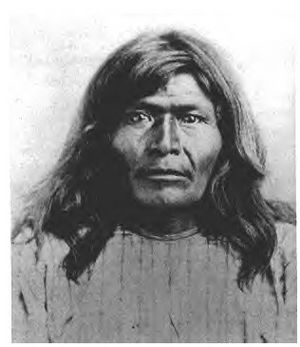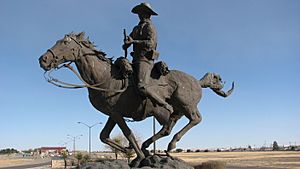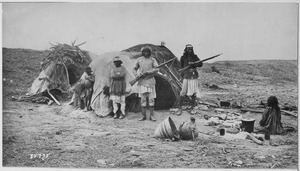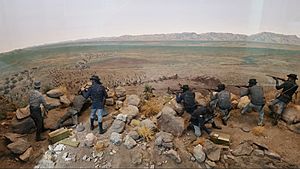Victorio's War facts for kids
Quick facts for kids Victorio's War |
|||||||
|---|---|---|---|---|---|---|---|
| Part of the Apache Wars, Apache–Mexico Wars | |||||||
 Victorio |
|||||||
|
|||||||
| Belligerents | |||||||
| Apache | |||||||
| Commanders and leaders | |||||||
| Victorio † Nana |
|||||||
| Strength | |||||||
| ca. 2,000 | ca. 150 | ||||||
The Apache can endure fatigue and famine and can live without water for periods that would kill the hardiest mountaineer ... In fighting them we must of necessity be the pursuers and unless we can surprise them by sudden and unexpected attack, the advantage is all in their favor ... You rarely see an Indian; you see the puff of smoke and hear the whiz of his bullets, but the Indian is thoroughly hidden in his rocks ...
Victorio's War, also known as the Victorio Campaign, was a conflict that started in September 1879. It involved the Apache followers of Chief Victorio, the United States, and Mexico. Victorio began this fight because he faced being arrested and forced to move from his home in New Mexico. He was supposed to go to the San Carlos Indian Reservation in southeastern Arizona.
Instead, Victorio led a guerrilla war across southern New Mexico, west Texas, and northern Mexico. He fought many battles and small fights with the United States Army. He also raided several towns. In October 1880, the Mexican Army killed Victorio and most of his warriors in the Battle of Tres Castillos. After Victorio's death, his helper Nana led another raid in 1881.
Experts say that Victorio was one of the best Apache leaders during these wars. No other Apache fighters would roam and fight in such large numbers again.
Contents
Why the War Started
In 1879, Victorio was about 55 years old. He was a skilled warrior and leader of the Warm Springs Apache band. Their homeland was near what is now Monticello, New Mexico. A special area was set aside for Victorio's band at Ojo Caliente. In 1876, about 916 Apache people lived there.
In the late 1870s, the U.S. government wanted all Apache bands to live at the San Carlos Indian Reservation. This reservation was in the Arizona desert. Victorio and his Warm Springs Apache people did not want to move. They tried to stop it peacefully and through fighting.
Life at San Carlos was very hard. Some Apaches there were enemies of the Warm Springs band. The government agents running the reservation were not fair. The reservation was also too crowded. There was little grass for animals and not much game to hunt. The water was bad, and it was very hot. Many Apaches died there, especially from malaria, a disease they rarely had before.
Colonel Edward Hatch, who led the U.S. army in New Mexico, and Lieutenant Charles W. Merritt, who was in charge at Ojo Caliente, tried to help Victorio. They asked the government in Washington, D.C., to let Victorio's band stay at Ojo Caliente. But their request was not approved.
First Fights
Victorio's Apaches began attacking settlers near Silver City in April 1879. The 9th Cavalry, made up of African-American soldiers called Buffalo Soldiers, started chasing Victorio's group.
On May 25, 1879, a group from the 9th Cavalry left Fort Bayard. They were looking for Victorio. On May 29, they found Victorio's band in a canyon in the Mimbres Mountains. Talks failed, and fighting began. The Apaches moved their families to safety and then left on foot. The cavalry destroyed the Apache camp. The 9th Cavalry lost one soldier. Sergeant Thomas Boyne later received the Medal of Honor for his brave actions that day.
In July 1879, Victorio and others were accused of certain actions by a court in Silver City, New Mexico. Victorio, Nana, and other Warm Springs Apaches were at the Mescalero reservation at this time. Victorio feared being arrested and forced to leave his homeland. So, on August 21, 1879, he left the reservation. About 80 warriors, their wives, and children went with him. More Apache followers soon joined his group. However, he never had more than 200 warriors fighting with him at any one time.
Victorio's main helpers were his sister Lozen and Nana. Nana was said to be over 70 years old in 1879.
Key Battles and Raids
1879 Conflicts
Ojo Caliente, September 4, 1879. Victorio and his followers went to their homeland at Ojo Caliente. They needed horses and stole about a dozen. At Ojo Caliente, 40 of Victorio's men attacked a company of the 9th Cavalry. They killed 5 soldiers and 3 civilians. They also captured 68 horses and mules.
McEvers Ranch, September 11, 1879. Victorio set a trap for a group of armed civilians looking for him. The Apaches killed ten civilians near McEvers Ranch. They also stole animals from nearby ranches and killed a family.
Las Animas Canyon, September 18, 1879. Victorio went north to the Black Range. Four companies of the 9th Cavalry found his trail. Victorio and 150 men ambushed the soldiers. They trapped the soldiers from the high ground for the rest of the day. Five or six soldiers and two or three Navajo scouts were killed. The canyon is now called "Massacre Canyon." Several soldiers, including First Sergeant John Denny and Lieutenant Day, received the Medal of Honor for their bravery.
Cuchillo Negro, September 29–30, 1879. This was a two-day running fight. 200 soldiers of the 9th Cavalry and 36 Indian scouts tried to find and defeat Victorio. Two soldiers were killed. Victorio likely had his first losses of the war here.
Lloyd's Ranch, October 10–12, 1879. Victorio raided the ranch and killed four armed civilians. On October 12, he killed five more from another group. The civilians left their goods to the Apaches.
Guzman Mountains, Mexico, October 27–28, 1879. Victorio crossed into Mexico. Major Morrow and 81 men of the 9th Cavalry followed him. Morrow tried to remove Victorio from the mountains but gave up due to lack of water. One soldier was officially reported killed.
Candelaria Mountains, Mexico, November 9, 1879. An armed group of 18 Mexican civilians looking for Victorio were trapped and killed. A rescue group of 35 men was also ambushed, and fifteen were killed. After these battles, Victorio moved through northern Mexico, gathering supplies.
1880 Conflicts
Percha Creek, January 12, 1880. Victorio returned to New Mexico. Major Morrow and the 9th Cavalry found him at Percha Creek. Morrow had one man killed. Nana later said the Apaches had 6 killed. Victorio continued north.
San Mateo Mountains, January 17, 1880. Victorio returned to Ojo Caliente and tried to make a deal to stay there. When that failed, he fought the 9th Cavalry. He killed one American officer and avoided being caught.
Caballo Mountains, January 30, 1880. Captain Rucker and the 9th Cavalry crossed the Rio Grande. The Apaches led them into a trap. The army had several horses killed and one soldier wounded before they left.
Aleman, February 3, 1880. Victorio entered the Jornada del Muerto. He was chased by Major Morrow and 5 companies of cavalry. He had a small fight with the 9th Cavalry, losing many horses. The 10th Cavalry (Buffalo Soldiers) came from Fort Bliss, Texas to help.
San Andres Mountains, February 9, 1880. The Apaches defeated a company of the 9th Cavalry. They drove them from the mountains and took supplies. Major Morrow and much of the 9th Cavalry were tired and low on horses.
Rio Grande Valley, March 1880. Victorio's war parties raided towns along the Rio Grande. They took animals, supplies, and ammunition. They killed at least 20 civilians.
Hembrillo Basin, April 5–8, 1880. This was the largest battle of the war. More than 500 soldiers and Indian scouts tried to surround Victorio's camp. Victorio managed to escape. The U.S. had two dead.
Mescalero Reservation, April 16, 1880. After Hembrillo Basin, 1,000 U.S. soldiers went to the Mescalero reservation. They wanted to stop the Mescaleros from helping Victorio. They imprisoned many men and killed 14 who fought back.
Alma, April 28, 1880. Victorio's forces split into several groups. They moved through the Mogollon Mountains, killing about 41 civilians, including the Alma Massacre.
Fort Tularosa, May 14, 1880. In the Battle of Fort Tularosa, about 100 Apaches attacked a fort. 25 soldiers of the 9th Cavalry defended it. Local people also hid in the fort. No defenders were hurt.
Palomas Creek, May 24, 1880. About 60 Apache scouts, led by Henry K. Parker, surprised Victorio and his followers. They killed about 30 men, women, and children before running out of bullets. Victorio was wounded. This was Victorio's first big defeat.
Deming, June 5, 1880. Parker's Apache scouts found a group of Apaches and killed 10 of them. This included Victorio's son Washington, who was a fierce warrior.
Northern Mexico, June and early July 1880. Victorio raided ranches in Mexico for supplies. He planned to trade animals for weapons in New Mexico. Mexican soldiers and Apaches were killed in clashes.
Tinaja de las Palmas (or Quitman Canyon), July 30, 1880. Victorio crossed into Texas. He met the 10th Cavalry led by Colonel Benjamin Grierson. Grierson's plan was to guard important waterholes. Grierson and his soldiers stopped Victorio and 125 warriors from reaching the water. One soldier was killed.
Rattlesnake Springs, August 6, 1880. Victorio needed water badly. He tried to go north from Mexico to Rattlesnake Springs, Texas. Grierson's soldiers got there first. Victorio tried several times to reach the water but was stopped. Grierson had 3 dead soldiers. Victorio turned back to Mexico after the battle.
Fort Quitman, August 10, 1880. Returning to Mexico, Victorio attacked a stagecoach. He killed the driver and wounded a passenger, James J. Byrne, who died a few days later.
Tres Castillos, October 14–15, 1880. Victorio hid in the desert of northern Mexico. He sent out groups to find ammunition and horses. A Mexican force of 250 men surrounded his camp. They killed 62 men and boys, including Victorio. They also killed 16 women and children and took 68 women and children as prisoners. Three Mexicans were killed. Nana was not there during the battle. Victorio's sister, Lozen, was one of the few Apaches to escape. This battle is sometimes called a "massacre" because Victorio had very little ammunition to fight back.
Ojo Caliente (Texas), October 28, 1880. Thirty-five Apaches were going to help Victorio. They ambushed and killed 5 soldiers of the 10th Cavalry near the Rio Grande.
1881 Conflicts (Nana's Raids)
Carrizo Canyon, August 12, 1881. 19 soldiers and Captain Parker chased Nana's band of about 40 to 60 Apaches into Carrizo Canyon. Five Apaches were killed, and two soldiers were killed. Nana escaped. Sergeant Thomas Shaw received the Medal of Honor.
Battle of Cuchillo Negro Creek, August 16, 1881. Lieutenant Gustavus Valois and his soldiers met a tired Mexican man. He said Nana's Apaches killed his family. Lieutenant George R. Burnett and 15 soldiers, with Mexican volunteers, looked for Nana. They found Nana's group, who were disguised as Mexicans. A long fight followed, and the Apaches went into the mountains. Private Augustus Walley, First Sergeant Moses Williams, and Lieutenant George Burnett all received the Medal of Honor.
Gavilan Canyon, August 19, 1881. Lieutenant George W. Smith and his soldiers were trapped by Chief Nana in Gavilan Canyon. Smith and three soldiers were killed right away. Sergeant Brent Woods took charge and led a charge up the canyon wall. Nana and his warriors left. Nana and his group escaped back to Mexico. Sergeant Woods received the Medal of Honor for his actions.





